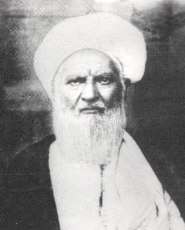Abdul-Karim Haeri Yazdi
Grand Ayatollah Hajj Sheikh Abdolkarim Haeri Yazdi (Persian: عبدالکریم حائری یزدی; Arabic: عبد الكريم الحائري اليزدي; ‘Abd al-Karī̄m al-Ḥa’irī̄ al-Yazdī̄) (1859 — 30 January 1937) was a Twelver Shia Muslim cleric and marja. He was known as the founder of an important Islamic seminary (hawza) in Qom, Iran, and for his "studied disinterest in politics". Among his students was Ruhollah Khomeini.
Abdul-Karim Haeri Yazdi عبدالکریم حائری یزدی | |
|---|---|
 | |
| Other names | Persian: عبدالکریم حائری یزدی |
| Personal | |
| Born | 1859 |
| Died | 30 January 1937 |
| Religion | Shia Islam (Usuli Twelver) |
| Other names | Persian: عبدالکریم حائری یزدی |
Early life
Haeri was born in the city of Meybod in Mehrjard village in southeastern Iran.[1] He studied at Yazd, then at Samarra under Grand Ayatollah Mirza Hassan Shirazi, completed his training at Najaf with Mohammad-Kazem Khorasani and Muhammad Kazim Yazdi.[2] In 1906, he reportedly became disenchanted with the politicization from the Iranian Constitutional Revolution and moved back to Najaf, Iraq. When Najaf became political, he moved to Karbala until political excitement cooled in 1913 when he moved back to Arak in Iran. By 1921, he was a "well-known and respected teacher" and "good administrator" and he accepted an invitation of Mullahs in Qom "to act as doyen" to the circles of learning in that Shrine town.[3]
Under Haeri, Qom moved from a respectable provincial Madrasah to a major center of learning close to the level of Najaf. Although "some of his contemporaries outshone" him as jurisconsults, Haeri became the marja for "many religious Iranians."[4]
Haeri's quietism was reflected in his willingness to meet cordially with both Shah Ahmad Shah Qajar and Prime Minister Reza Khan.[5]
Qom Seminary
It is because of the efforts of Ayatollah Abdul Karim Haeri that Qom today has become the epicenter of Shia learning. In the year 1921, Ayatullah Haeri accepted the invitation of the people of Qom and came to Qom with his older son. Two months after his arrival, Haeri attended a meeting with respect to the formation of a hawza at the house of Ayatullah Paeen Shahri. The meeting involved businessmen, learned scholars and jurists including Ayatullah Bafqi, Ayatullah Kabir and Ayatullah Faiz. This meeting lasted for hours and the final outcome was delegated to Ayatullah Haeri. Ayatullah Haeri initially believed that the Hawza in Qom should be formed by the elders and residents of Qom. However, due to the intense persistence of the learned scholars, he accepted the responsibility on the following condition - he said: ‘I will perform an Istikhara on the basis that is it feasible for me to stay in Qom and invite the students and teachers who are waiting for my return to come here or not?’ Early the next morning, before leading the salaat-e-Fajr,Ayatullah Haeri reached for a Qur’an and stood in the Haram of Bibi Ma’sooma engaging in dua before performing the Istikhara. It is narrated that Ayatullah never used to do Istikhara by use of the Qur’an and he used to say that I don’t fully understand if the verse is good or bad. However, when he performed the Istikhara with relation to whether or not he should stay in Qom, he left everything in the hands of Allah, and when the verse of Qur’an was chosen: ‘Take this shirt of mine, and cast it upon my father’s face; he will regain his sight, and bring me all your folks,’4 Yusuf [12:93] it left him in no doubt as to where his future lay. He therefore immediately began the task of setting up of a Hawza and in the process wrote to all his former students in Arak to invite them to Qom.[6]
Children
- Morteza Haeri Yazdi
- Mehdi Haeri Yazdi
- Cobra Haeri Yazdi
Students
- Ayatollah Borqei
- Ruhollah Khomeini
- Abolhasan Rafii Qazvini
- Mohammad-Reza Golpaygani
- Mohammad Ali Araki
- Sayeed Shahabuddin Marashi Najafi
- Jafar Eshraghi
- Sayeed Ahmad Zanjan
- Ayatollah Haj Mirza Khalil Kamareyi
- Mohammad Mohaghegh Damad
- Shamseddin Mataji Kojouri
- Mirza Hashem Amoli
See also
- Ruhollah Khomeini
- List of Islamic studies scholars
- List of Maraji
- List of Ayatollahs
References
- Momen 1985, p. 312.
- Momen 1985, p. 313.
- Mottahedeh, Roy P. (1985). The mantle of the Prophet: religion and politics in Iran. Simon and Schuster. p. 228. ISBN 978-0-671-55197-1.
- Mottahedeh 1985, p. 229.
- Mottahedeh 1985, p. 229".
- Haeri Yazdi. Ayatollah Abdulkarim. Archived from the original on 2018-12-19. Retrieved 2015-08-09.
Sources
- Momen, Moojan (1985). An Introduction to Shiʻi Islam: The History and Doctrines of Twelver Shiʻism. Yale University Press. ISBN 978-0-300-03531-5.CS1 maint: ref=harv (link)